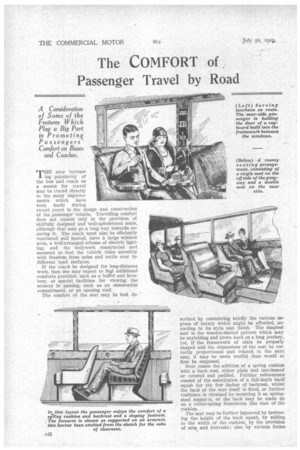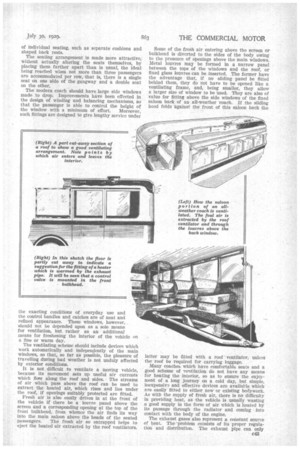The COMFORT of .
Page 64

Page 65

Page 66

If you've noticed an error in this article please click here to report it so we can fix it.
Passenger Travel by Road
A Consideration of Some of the Features Which Play a Big Part in Promoting Passengers Comfort on Buses and Coaches.
Pir HE ever increas
ing popularity of the bus and coach as a means for travel may be traced directly to the many improvements which have been made during recent years in the design and construction of the passenger vehicle. Travelling comfort does not consist only in the prevision of skilfully designed and well-upholstered seats, although that may go a long way towards ensuring it. The coach must also be efficiently ventilated and heated, have a. large window area, a well-arranged scheme of electric lighting, and the bodywork constructed and mounted so that the vehicle rides smoothly with freedom from noise and rattle over indifferent road surfaces.
If the coach be designed for long-distance work, then one may 'expect to find additional comforts provided, such as a buffet and lavatory, or special facilities for viewing the scenery in passing, such as an observation compartment, or an opening roof.
The comfort of the seat may be best de scribed by considering briefly the various aegrees of luxury which might be afforded, according to its style and finish: The simplest seat is the wooden-slatted pattern which may be unyielding and prove hard on a long joutney, yet, if the framework of slats be proparly shaped and the dimensions of the seat be correctly proportioned and related to the next seat, it may be more restful than would at first be supposed.
Next. comes the addition of a spring cushion with a back rest, either plain and untrimmed or covered and padded. Further refinements. consist of the substitution of a full-depth back'. squab for the few inches of backrest, whilst the back of the seat itself Is fixed, or further resilience is obtained by mounting it on springsteel supports, or the back may be made up on a coiled-spring foundation like that of the cushion.
The seat may be further improved by Increasing the height of the back squab, by adding to the width of the cushion, by the provision of arm and footrests; also by various forms of individual seating, such as separate cushions and shaped hack rests.
The seating arrangement is made more attractive, without actually altering the seats themselves, by placing them farther apart than is usual, the ideal being reached when not more than three passengers are accommodated per row, that is, there is a single seat on one side of the gangway and a double seat on the other.
The modern coach should have large side windows made to drop. Improvements have been effected in the design of winding and balancing mechanisms, so that the passenger is able to control the height of the window with a minimum of effort. Moreover, such fittings are designed to give lengthy service under
the exacting conditions of everyday use and the control handles and catches are of neat and refined appearance. These windows, however, should not be depended upon as a sole means for ventilation, but rather as an additional means for freshening the interior of the vehicle on a fine or warm day.
The ventilating scheme should include devices which work automatically and independently of the main windows, so that, so far as possible, the pleasure of travelling during bad Weather is not unduly affected by exterior conditions.
It is not difficult to ventilate a moving vehicle, because its movement sets up useful air currents which flow along the roof and sides. The streams of air which pass above the roof can be used to extract the heated air, which rises and lies under the roof, if openings suitably protected are fitted.
Fresh air is also easily driven in at the front of the vehicle if there be a louvre panel above the screen and a corresponding opening at the top of the front bulkhead, from whence the air finds its way into the main saloon above the heads of the seated passengers The fresh air so entrapped helps to eject the heated air extracted by the roof ventilators.
Some of the fresh air entering above the screen or bulkhead is diverted to the sides of the body owing to the presence of openings above the main windows. Metal louvres may be formed in a narrow panel between the tops of the windows and the roof, or fixed glass louvres can be inserted. The former have the advantage that, if no sliding panel be fitted behind them, they do not have to be opened like a ventilating frame, and, being smaller, they allow a larger size of window to be Used. They are also of value for fitting above the side windows of the fixed saloon back of an all-weather -coach. If the sliding hood folds -against the front of this saloon back the
latter may be fitted with a roof ventilator, unless the roof be required for carrying luggage.
Many coaches which have comfortable seats and a good scheme of ventilation do not have any means for heating the interior, so as to ensure the enjoyment of a long journey on a cold day, but simple, inexpensiva and effective devices are available which are easily fitted to either new or existing bodywork. As with the supply of fresh air, there is no difficulty in providing heat, as the vehicle is usually wasting a good supply in the form of air which is heated by its passage through the radiator and coming into contact with the body of the engine.
The exhaust gases also represent a constant source of heat. The -probletn coasists of its proper regulation and distribution. The exhaust pipe can only (43
be utilized to heat the incoming air and must still be as rigidly excluded from the interior of the coach as when no heating system is installed.
The Thermo-Economic or T.E. system of heating made by Messrs. John Kay and Graham, makes use of the warm .fresh air which passes through the radiator. The installation consists of an air-collecting box with suitable distributing ducts and controlling valves, the apparatus being made of light sheet iron or aluminium. As the exhaust gas is not employed by this system there is no urgent need for the maintenance of air-tight joints. The sheet-metal collecting box is suspended above the engine and com
municates with the back of the radiator. At the rear of the box there is a flexible connection joining it to the main duct which leads to the interior.
If the vehicle be a double-decker a duct is compactly fitted running from the back of the bonnet up the front of the bulkhead. The heaters provided under the seats are of semi-circular pattern.'
In the case of the heater which has been evolved for use on the coaches of Kingston and Modern Travels, Ltd., advantage is taken of the heat radiated from the exhaust pipe. A long steel box about onethird larger in diameter than the exhaust pipe, and from three to four feet long according to the size of the interior to be heated, is welded around the outside of the exhaust pipe. From one end of this box 'a flexible pipe of about two inches diameter is led by the shortest path available to the interior of the coach. Behind the radiator is fitted a large funnel, or scoop, communicating with the front end of the box which forms a jacket around the exhaust pipe. The fresh air is driven by the fan into the collecting funnel and so into the box, where it is heated by, but does not come into contact with, the exhaust.
The Tropic-Aire heater, an American invention, which is marketed in this country by the Buda Company, consists of an auxiliary radiator which is heated by the engine cooling water running through it. Two electric fans behind this radiator impel air through the honeycomb, which thus becomes heated and maintains a constant supply of warm air. • The Thermorad of A. W. Chapman, Ltd., is a combined exhaust heater and footwarmer. The exhaust is jacketed in a special aluminium heater box. This is a well-made one-piece casting with the joint fares machined true and air tight. For a large bus, say a 35-seater, four Therraorads or heater boxes are let into the floor and supported on light cross-bars or mild-steel straps.
The heater boxes are arranged more or less equidistant down the centre gangway. The special bustype valve is placed about midway down the main saloon, from whence the exhaust is distributed to the heaters with outlets fore and aft.
The A.L. air inlet or venti-duct heater of Augers, Ltd., collects fresh air by means of a bell-shaped device mounted outside the front of the vehicle. The mouth of this inlet is protected with gauze, so as to exclude dust and other particles, whilst the down tube has drain holes at the bottom for the escape of any condensation. The inlet-pipe then passes under the floor of the coach, where it is connected to a large exhaust jacket communicating with the uptakes and floor ventilators. This heating apparatus includes a roof ventilator, operated by worm gearing, which is considered an essential part of any effective heating system. A forced draught can be arranged for very cold climates. • The finishing touch to the completely equipped long-distance coach is a buffet, so that a light repast may be served daintily and partaken pf in comfort. The location of the buffet is best arranged over the wheel-arch and the success of the service rendered depends on the amount of space which can be allotted to the storage and preparation of food and the necessary accessories. Widely spaced seats are also essential for an enjoyable meal.
It is suggested that it would be an advantage for the passenger if panels were formed between the side windows, so that small lockers could be made here for the storage of a cruet, glasses or any refreshment which the passenger himself might bring with hint The doors of these side lockers could be fitted with mirrors. With the development of long-distance travel by road the provision of refreshment facilities on coaches will become important.












































































































